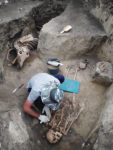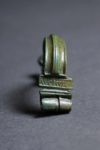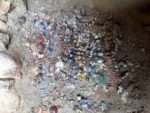 A grave containing the remains of an Alan woman lavishly adorned with Roman jewelry has been unearthed in the Zayukovo-2 burial ground in Kabardino-Balkaria in Russia’s North Caucasus region. She was found in a group grave, probably a family tomb, along with three other men. Artifacts found inside the graves date it to the 1st century or early 2nd.
A grave containing the remains of an Alan woman lavishly adorned with Roman jewelry has been unearthed in the Zayukovo-2 burial ground in Kabardino-Balkaria in Russia’s North Caucasus region. She was found in a group grave, probably a family tomb, along with three other men. Artifacts found inside the graves date it to the 1st century or early 2nd.
“She had two rings on her fingers manufactured with the use of quite a complex technology,” said archaeologist Anna Kadieva, head of an expedition at Zayukovo-2 burial site.
Ms Kadieva said the fact the jewelry was Roman-made is “beyond any doubt.”
She added: “It is quite expensive for the time, and priceless for the barbarian world because there was no glass production in the North Caucasus back then.”
The beads on her shoes were made of glass but also contained an orange-colored mineral called carnelian that is part of the Quartz family.
She also wore two rings on her fingers manufactured with the use of quite a complex technology. Each of them was cast from transparent white glass with golden fibers from the same material, with a dark glass
installation in the middle[…]
The woman was also discovered wearing a bright violet amethyst medallion as seen in this picture. The team say this would have been ‘priceless’ for the region as they had no glass blowing technology at the time
Archaeologists think she was the wife or close family member of an important warrior or chieftain. The sheer density of expensive imported jewelry is evidence of significant wealth, and may represent a trend among the elite Alan warrior class of gifting Roman jewelry to their nearest and dearest. Or maybe she was just lucky.
 One of the men in the grave with her was buried with accessories indicating he was a warrior. A fibula of the Aucissa type, a hinged brooch with a high semi-circular arched bow that attached to a foot. The type is named after the word “AVCISSA” inscribed over the hinge of most of these fibulae. It is the maker’s mark of a workshop that mass-produced them starting in the 1st century A.D.; Aucissa fibulae have been found most often in the graves of Roman soldiers.
One of the men in the grave with her was buried with accessories indicating he was a warrior. A fibula of the Aucissa type, a hinged brooch with a high semi-circular arched bow that attached to a foot. The type is named after the word “AVCISSA” inscribed over the hinge of most of these fibulae. It is the maker’s mark of a workshop that mass-produced them starting in the 1st century A.D.; Aucissa fibulae have been found most often in the graves of Roman soldiers.
The deceased was also buried wearing two Roman buckles in silver and bronze, one on each shoe. A horse bridle with cheek pieces attached to the ends of the bit found in the grave was also of Roman manufacture. It’s possible these were spoils of battle, but archaeologists believe it’s more likely this was a local warrior who fought for Rome.
 In the 1st century, the Alani migrated westward to the Pontic steppe and settled north of the Caucasus. Incursions south into Sarmatian territory in the foothills of the Caucasus resulted in cultural interchange seen in the funerary practices. Some of the Alan burials in Zayukovo-2 have Sarmatian features as well as their own culturally distinctive ones.
In the 1st century, the Alani migrated westward to the Pontic steppe and settled north of the Caucasus. Incursions south into Sarmatian territory in the foothills of the Caucasus resulted in cultural interchange seen in the funerary practices. Some of the Alan burials in Zayukovo-2 have Sarmatian features as well as their own culturally distinctive ones.
According to Flavius Josephus: “These Alans plundered the country without opposition, and with great ease, and proceeded as far as Armenia, laying waste all before them. Now, Tiridates was king of that country [Tiridates I of Armenia], who met them and fought them but was lucky not to have been taken alive in the battle”. The peace between Parthia and Rome lasted, until Trajan invaded Armenia in 114AD.
Nearby ‘Roman Armenia’ refers to the rule of parts of Greater Armenia by the Roman Empire. According to Claudius Ptolemy in the 2nd century AD in Alexandria: “The Greater Venedae races inhabit Sarmatia along the entire Venedicus bay [Baltic Sea]; and above Dacia are the Peucini and the Basternae; likewise along the whole coast of the Meotis [the Black Sea] live the Iazyges and Rhoxolani. The Amaxobii [(H)Amaxobians, Ἁμαξόβιοι] and the Scythian Alans populate further inland.”
The technique used for the glass ring reminds of the ‘Wallertheim puppy’ (a.k.a glass dog from Wallertheim): 2.1 cm by 1.6 cm (0.83 x 0.63 inches). The puppy is made of blue glass covered with white threads and was recovered as part of a find of grave goods in a child’s grave from the 2nd century BC, the late Late Latène Period, in 1951. A white thread-like structure is attached to the blue glass body. Also at the ears, the tail and the legs such a structure is put on, but in yellow instead of white. The piece is currently exhibited in the Landesmuseum Mainz.
———-
From a Chinese point of view: “Yancai lies some 2,000 li [832 km] northwest of Kangju. The people are nomads and their customs are generally similar to those of the Kangju people. The country has over 100,000 archer warriors, and borders on a great shoreless lake.” (travels of Chinese diplomat Zhang Qian, 2nd century BC ). 3rd century (AD) Weilüe: “..the kingdom of Yancai [between the Black and Caspian Seas], which is also called Alan. They all have the same way of life as those of Kangju. To the west, they border Da Qin [Roman territory], to the southeast they border Kangju..”.
From 215–250 AD, Alan power on the Pontic Steppe was broken by the Goths, however, upon the Hunnic defeat of the Goths on the Pontic Steppe around 375 AD, many of the Alans migrated westwards along with various Germanic tribes. They crossed the Rhine in 406 AD along with the Vandals and Suebi, and the Migration Period set in, …as did consequently, just a few decades later, the Medieval Age :yes: